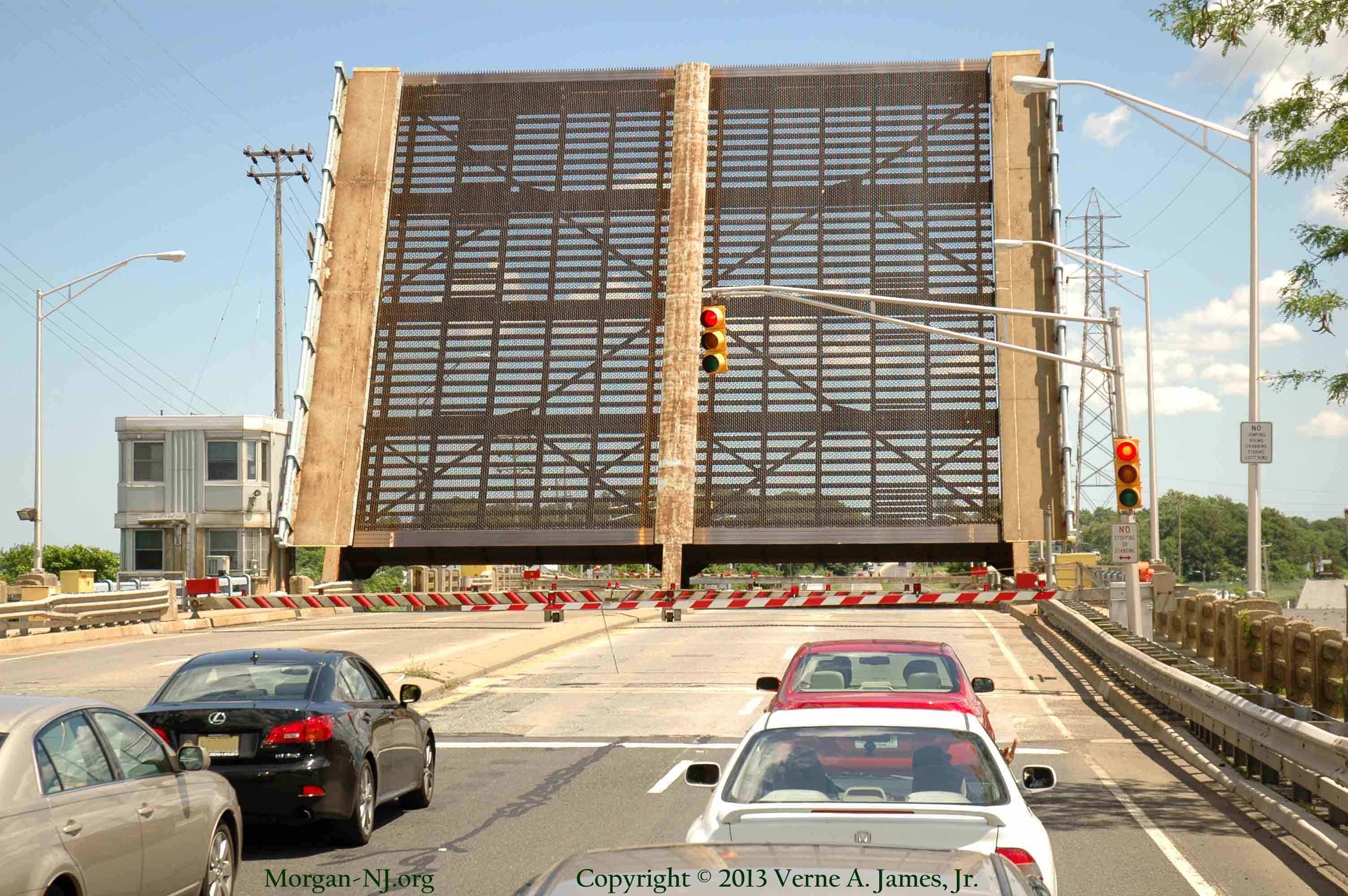 Anyone traveling on Route 35 through Morgan in the summer months has likely encountered something somewhat out of the ordinary when trying to cross over the Morgan Bridge – standstill traffic. This is no ordinary traffic jam but rather a long Morgan tradition – trying to cross Cheesequake Creek. Reportedly, in stage coach days, people would wait at the Old Spye Inn for the tide to go out until the creek was low enough to cross it. In the 1920’s, prior to the building of Route 35 and the current Morgan Bridge, enormous traffic jams occurred at the grade level crossing where Old Spye Road crossed the New York and Long Branch Railroad. Imagine 25,000 cars trying to cross railroad tracks when on the same day significantly more than the current 74 trains per day were bringing Memorial Day city folk to the Jersey Shore. With this perspective, waiting a little bit for the bridge to close these days should be considered as a welcome break and a chance to step out and stretch your legs.
Anyone traveling on Route 35 through Morgan in the summer months has likely encountered something somewhat out of the ordinary when trying to cross over the Morgan Bridge – standstill traffic. This is no ordinary traffic jam but rather a long Morgan tradition – trying to cross Cheesequake Creek. Reportedly, in stage coach days, people would wait at the Old Spye Inn for the tide to go out until the creek was low enough to cross it. In the 1920’s, prior to the building of Route 35 and the current Morgan Bridge, enormous traffic jams occurred at the grade level crossing where Old Spye Road crossed the New York and Long Branch Railroad. Imagine 25,000 cars trying to cross railroad tracks when on the same day significantly more than the current 74 trains per day were bringing Memorial Day city folk to the Jersey Shore. With this perspective, waiting a little bit for the bridge to close these days should be considered as a welcome break and a chance to step out and stretch your legs.
Of course if you were in a big hurry to begin with, you would have taken the Garden State Parkway which crosses Cheesequake Creek one mile further inland where no draw bridge is necessary.
The current Morgan Bridge is at least the third, and probably the fourth, road bridge to span Cheesequake Creek at this location (see the to-be-included “The Bridges of Cheesequake Creek” page). What remains of the predecessor bridge is a closed off concrete road running parallel on the bay side just to the east on the south side of the creek. If any of the readers has more information – especially photographs – of any previous bridges at this site, please leave your contact info in the “Comments” section below.
The movable portion of Morgan Bridge is like a huge seesaw. On one side of its horizontal axis is the road bed which tilts up to let sailboats pass through. On the other side of the horizontal axis is a counter weight which tilts down when the bridge opens. This counterweight balances the weight of the road bed and allows for a smaller motor to be used to open and close the bridge. This type of bridge is technically known as a Bascule bridge. “Bascule” is a French word meaning “Seesaw”. When the roadbed on the southeast side tilts up, the counterweight on the northwest side tilts down.
The following is additional information regarding this bridge which is one of the icons of Morgan still physically in existence:
- Bridge Type: Single Leaf Bascule
- Number of Lanes: Two northbound & two southbound
- Leaf Contains: Four lanes of traffic, median, two shoulders and two sidewalks.
- Total Length: 712.0 feet
- Deck Width: 67.9 feet
- Number of Spans: 9
- Length of Longest Span: 74.2 feet
- New JerseyBridge # / NJDOT Structure #: 1222150
- Vertical Clearance in the Closed Position: 25 feet at mean high water
- Vertical Clearance in the Closed Position: 30 feet at mean low water.
- Average daily traffic (as of 2006): 28,540
- Construction Completed: 1942
- Alteration Dates: 1956, 1986 (Second floor added to Operator’s house)
- Designer/Patent: NJ State Highway Department Bridge Division
- Sponsor/Owner: New Jersey Department of Transportation (NJDOT)
- Mileposts: 47.1 – 47.3
- Material: Steel and concrete
- Regulatory Entity: Coast Guard, Department of Homeland Security
- Operation of the bridge is as per the Code of Federal Regulations (CFR):
Title 33 – Navigation and Navigable Waters
Subchapter J – Bridges
Part 117 – Drawbridge Operation Regulations
Subpart A – General Requirements
Subpart B – Specific Requirements
709 – Cheesequake Creek - The bridge opening schedule is listed at § 33 CFR 117.709.
In the Fall of 2011, extensive maintenance work started on the Morgan Bridge. See the to-be-included “Morgan Bridge Improvements” page for details about this effort.
Original posting September 2, 2009.
As a teenager I remember the Morgan Bridge and the creek below it as being our playground. We’d swim there every summer, diving off the pilings and the catwalk underneath. The bridge tender would come out yelling at us as we jumped off the bridge. It was thriving down there on both sides of the creek–always something going on. After the Robert E. Lee burned down and the real estate disappeared, the area became quite deserted. — The bridge has recently been renovated; new road bed, new grating, new sidewalks, etc. Hopefully it will open and close more quickly over the summer and early fall.